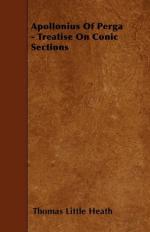|
This section contains 268 words (approx. 1 page at 300 words per page) |
World of Scientific Discovery on Apollonius of Perga
Although little is known of Apollonius' early life, he is thought to have been born about 261 b.c. in Alexandria, Egypt. He may have studied mathematics at the Museum in Alexandria, the school where the renowned mathematician, Euclid, taught. In any case, Apollonius is credited with making advances in the mathematical ideas of Euclid, particularly his study of certain geometric figures, known as conic sections.
Apollonius is most noted for his eight-volume treatise entitled The Conics, although only seven out of the original eight books still exist. The first four books consisted of an introduction and account of the current state of mathematics provided by his predecessors. In the last four books, Apollonius published his own work on conic sections. By cutting through double cones at particular angles, he produced several new geometric defintions for the conics that Apollonius termed ellipse, parabola, and hyperbola. These curves are important to the study of geometry and are widely used today in astronomy, ballistic science and rocketry. Apollonius' book also influenced Greek astronomer and cosmologist Ptolemy.
The works of "the Great Geometer," as Apollonius has been called, were not fully appreciated in his time, but have since been recognized for their true worth. In Isaac Newton 's lifetime some eighteen centuries later, it was discovered that conic sections (commonly ellipses) form the paths followed by planets, moons, and other bodies in space.
A second surviving treatise written by Apollonius, Cutting off of a Ratio, originally appeared in Greek, but was preserved in an Arabic version and translated into Latin in 1706; however, it is not considered of great mathematical significance.
|
This section contains 268 words (approx. 1 page at 300 words per page) |


